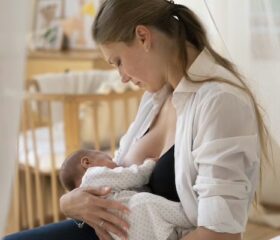Sudden Infant Death Syndrome (SIDS): Risks and Prevention
As a new parent, you’re probably worrying endlessly about your baby’s safety, especially if you’ve heard of sudden infant death syndrome (SIDS) before.

All newborns are at risk of SIDS for the first 6 months of life, particularly when they’re sleeping. SIDS is rare, but scientists still aren’t sure what causes it, making it all the more anxiety-inducing.
Fortunately, there are a few simple practices that can reduce your baby’s risk of SIDS. Significantly, this includes putting your baby to sleep on her back (and never her stomach).
Read on to learn what we know about SIDS and what you can do to protect your baby while she sleeps.
What is SIDS?
Sudden infant death syndrome (SIDS) is when a baby under 12 months old suddenly and inexplicably dies, usually during sleep. 1 Even after a thorough investigation, including an autopsy, a look at the baby’s health history, and an examination of the sleep environment, there’s no identifiable cause.
Because it often happens during sleep, SIDS used to be called “crib death.”
What’s the difference between SIDS and SUID?
You might also hear the term “sudden unexpected infant death” (SUID). This is a broader category that includes all sudden infant deaths, not just SIDS. 1
It covers things like accidental suffocation or strangulation, infection, and undiagnosed genetic or metabolic conditions. If a doctor can identify a cause, infant death is categorized as SUID, not SIDS. 2
How common is SIDS?
The good news is that, as mentioned, SIDS is rare, accounting for about 38.4 deaths per 100,000 live births. It affects less than 0.04% of babies. 3
Thanks to safe sleep campaigns like “Back to Sleep” (now “Safe to Sleep”), SIDS rates have dropped by more than half since the 1990s. 3 SIDS rates have dropped by roughly 50% in countries that have adopted back-sleeping recommendations. 3
In 2022, there were approximately 1,529 SIDS deaths in the US. 4
When does SIDS happen?
Most SIDS cases occur between 1 month and 4 months of age. The vast majority happen before a baby is 6 months old. 5
Even after 6 months, however, your baby is still at risk of SIDS, and it remains the leading cause of death for 1-month to 12-month-old babies. 6
Experts recommend following safe sleep practices throughout your baby’s entire first year. Your baby’s risk drops when her motor development allows her to move freely and sleep in various positions. However, it’s still important to remember to put her to bed on her back, no matter what her favorite sleeping position is.
There are resources for parents who’ve lost a baby to SIDS
Losing a baby to SIDS is a heartbreaking experience for any parent. If it’s happened to your family, you don’t have to suffer alone. Groups like The Compassionate Friends and Share Pregnancy & Infant Loss Support offer support to parents grieving the loss of their baby.
What causes SIDS?
Researchers haven’t found one single cause of SIDS, but the most accepted theory is called the “triple risk model.” 7 This suggests that SIDS occurs when three factors overlap:
A vulnerable infant
Some babies may have subtle defects or abnormalities in the brainstem, the area that controls breathing, heart rate, temperature, and arousal from sleep.
Research has also shown that rare genetic mutations, particularly in genes affecting the heart’s electrical system (conduction) or fatty acid metabolism, can cause fatal heart rhythms or metabolic crises that mimic SIDS.
Additionally, low levels of certain brain enzymes may interfere with your baby’s ability to wake up or respond to low oxygen. 8
A critical developmental period
During the first 6 months, your baby matures neurologically and physiologically. This window of rapid change brings about a lot of instability to her regulation of sleeping and waking, breathing, heart rate, and blood pressure. 9
All these changes make her more vulnerable to external stressors, described below. 8
External stressors and risk factors
In babies, stomach or side-sleeping is thought to be a stressor that can interact with the factors mentioned above to cause SIDS, possibly by disrupting breathing. 10
Other potential stressors and risk factors include: 11
- Soft sleep surfaces: The risk of suffocation comes into play when babies sleep with a pillow, comforter, or plush mattress, which can obstruct your baby’s airway.
- Overheating: If your baby gets too warm, she may struggle to wake herself.
- Tobacco & alcohol use: Your baby is more at risk if she was exposed to tobacco smoke during pregnancy or after birth, as well as drugs while you’re pregnant. Moreover, you can’t drink wine or any other alcohol while you’re pregnant, as this can also increase the risk of SIDS (and birth defects).
- Premature birth or low birth weight: Babies that are born early may have underdeveloped respiratory and nervous systems.
- Lack of prenatal care: There’s strong evidence to suggest that routine prenatal care lowers your baby’s risk of SIDS. Conversely, its lack is a stressor that can elevate the risk.
- Young maternal age: Babies of teen moms are statistically at a higher risk of SIDS.
- Race or ethnicity: Non-Hispanic Black, American Indian, and Alaska Native babies experience higher rates of SIDS. 12
- Being male: SIDS affects baby boys more than girls. 13
Despite what you may have read online, vaccines, choking, minor illnesses, and vomiting don’t cause SIDS. 14
How to reduce the risk of SIDS
While you can’t eliminate the risk of SIDS entirely, you can take steps to protect your baby, especially during sleep. Take these steps:
Follow the ABCs of Safe Sleep
Always follow the “ABCs of Safe Sleep” guidelines from the American Academy of Pediatrics (AAP): 15 16
- A (Alone): Your baby should sleep “alone” and not in the same bed as you (although she should sleep in the same room as you until she’s 6 months old)
- B (Back): Always place your baby on her back to sleep, both for naps and at night.
- C (Crib): Use a crib, bassinet, or play yard with a firm, flat mattress and a fitted sheet, with no loose sheets.
Take other preventive measures to ensure safe sleep
You should also take the following precautions to protect your baby at night:
- Pick a safe crib: Make sure your baby’s crib meets current safety standards and is approved by the Consumer Product Safety Commission (CPSC). Don’t use one with broken or missing parts. Be cautious with hand-me-downs, which may not meet today’s safety requirements. 17
- Avoid inclined sleepers, bumpers, and weighted sleepwear: These are now strongly discouraged due to the risk of suffocation. 18
- Stop your baby from overheating: Dress your baby in lightweight sleepwear and keep the room’s temperature between 68 °F and 72 °F (20°C–22°C). 13 A good rule of thumb is to touch the back of your baby’s neck or chest. If she feels hot or is sweating, remove a layer.
- Don’t let your baby sleep outside the crib: Move your baby to her crib if she falls asleep in her car seat, stroller, or swing. These devices are designed for motion, not long naps. If your baby dozes off and the crib isn’t nearby, gently transfer her to a firm, flat surface.
- Prepare for feeding in bed: If you think you might fall asleep while breastfeeding, do so in your bed (not on a couch or armchair, which poses more risk), and remove pillows or blankets. Once you wake up, move your baby to her crib.
- Offer a pacifier at bedtime: This may lower your baby’s risk of SIDS. 19 Skip pacifiers with cords or clips. If it falls out while your baby sleeps, that’s fine—no need to pop it back in.
Share a room with your baby (but not a bed)
The AAP recommends you share a room with your baby for at least the first 6 months of her life, and ideally up to one year. 11 Having her sleep in your room (in her own crib or bassinet) can cut the risk of SIDS in half. 20
When you monitor your baby’s breathing at night, don’t panic if she takes rapid breaths, pauses, then resumes breathing. This is called periodic breathing, and it’s usually normal for infants. 21 However, if she turns blue, gasps, or stops breathing for longer than 20 seconds, call 911 immediately. 22
Don’t rely on advanced baby monitors
It’s tempting to rely on high-tech monitors that track breathing or heart rate, but unlike sleeping in the same room, there’s no evidence they prevent SIDS. 20 In fact, they may offer a false sense of security, or, conversely, cause unnecessary stress and anxiety. Because many are oversensitive, they may also lead to interrupted sleep for both you and your baby.
Unless your pediatrician prescribes them for a health condition, you’re best off skipping them.
Practice safe swaddling
Swaddling can be calming for newborns, but it’s important to learn how to swaddle your baby correctly and stop when she learns how to roll over (usually around 2 months to 4 months old). 11 Ensure the swaddle isn’t too tight and doesn’t restrict hip movement, and that it isn’t too loose (loose blankets can elevate SIDS risk). 23
Keep your baby up-to-date with her vaccines
Keeping your baby up to date on her immunizations not only protects against dangerous diseases—it may also reduce the risk of SIDS. Several studies have shown that vaccinated infants have a significantly lower SIDS risk than those who aren’t immunized. 24
Exclusively breastfeed your baby if you can
As well as protecting your baby from many infections and illnesses, exclusively breastfeeding for the first 6 months will reduce her risk of SIDS. 25 This may be partially because breastfed babies wake more easily, which may help avoid the sleep-related issues tied to SIDS.
The AAP recommends breastfeeding for at least the first year (even after your baby starts eating solids) or even longer if you want to. 26
Final thoughts
Again, your baby’s risk of SIDS drops sharply after 6 months. 27 Once your baby can roll over both ways and lift her head easily, she can protect her own airway and you can mostly stop worrying about SIDS. That said, it’s still best to put her to sleep on her back every time.
Hang in there. Before you know it, you and your baby will both be sleeping far more soundly.
Article Sources
- Safe to Sleep. "What is SIDS?" Retrieved September 2, 2025.
- Pediatrics. "Classification System for the Sudden Unexpected Infant Death Case Registry and its Application" Retrieved September 2, 2025.
- Cureus Journal of Medical Science. "Sudden Infant Death Syndrome: Risk Factors and Newer Risk Reduction Strategies" Retrieved September 2, 2025.
- Centers for Disease Control and Prevention. "Data and Statistics for SUID and SIDS" Retrieved September 2, 2025.
- University of Adelaide Press. "Sudden Infant Death Syndrome: An Overview" Retrieved September 2, 2025.
- Centers for Disease Control and Prevention. "About SUID and SIDS" Retrieved September 2, 2025.
- Safe to Sleep. "What Causes SIDS?" Retrieved September 2, 2025.
- The Application of Clinical Genetics. "Genetic Factors Underlying Sudden Infant Death Syndrome" Retrieved September 2, 2025.
- National Center for Education in Maternal and Child Health. "What is SIDS?" Retrieved September 2, 2025.
- Nemours KidsHealth. "Sudden Infant Death Syndrome (SIDS)" Retrieved September 2, 2025.
- HealthyChildren.org. "How to Keep Your Sleeping Baby Safe: AAP Policy Explained" Retrieved September 2, 2025.
- Safe to Sleep. "What Are the Known Risk Factors?" Retrieved September 2, 2025.
- MedlinePlus. "Sudden infant death syndrome" Retrieved September 2, 2025.
- Cleveland Clinic. "SIDS (Sudden Infant Death Syndrome)" Retrieved September 2, 2025.
- Centers for Disease Control and Prevention. "Providing Care for Babies to Sleep Safely" Retrieved September 2, 2025.
- Nationwide Children’s Hospital. "The ABC's of Safe Sleep" Retrieved September 2, 2025.
- U.S. Consumer Product Safety Commission. "Safe Sleep – Cribs and Infant Products" Retrieved September 2, 2025.
- HealthyChildren.org. "Inclined Sleepers, Soft Nursing Pillows, & Other Baby Products to Avoid" Retrieved September 2, 2025.
- Pediatrics. "Do Pacifiers Reduce the Risk of Sudden Infant Death Syndrome? A Meta-analysis" Retrieved September 2, 2025.
- HealthyChildren.org. "Reduce the Risk of SIDS & Suffocation" Retrieved September 2, 2025.
- MedlinePlus. "Apnea of prematurity" Retrieved September 2, 2025.
- MedlinePlus. "Brief resolved unexplained event - BRUE" Retrieved September 2, 2025.
- HealthyChildren.org. "Safe Sleep: Back is Best, Avoid Soft Bedding, Inclined Surfaces & Bed Sharing" Retrieved September 2, 2025.
- Centers for Disease Control and Prevention. "Sudden Infant Death Syndrome (SIDS) and Vaccines" Retrieved September 2, 2025.
- Safe to Sleep. "Breastfeeding & Safe Sleep" Retrieved September 2, 2025.
- American Academy of Pediatrics. "Updated AAP guidance recommends longer breastfeeding due to benefits" Retrieved September 2, 2025.
- Pediatrics. "Risk Factor Changes for Sudden Infant Death Syndrome After Initiation of Back-to-Sleep Campaign" Retrieved September 2, 2025.







